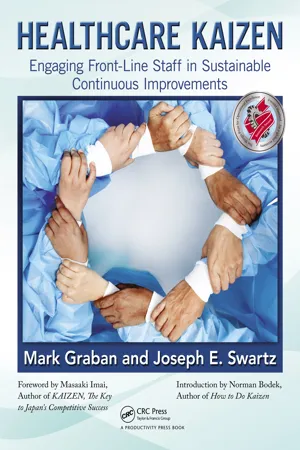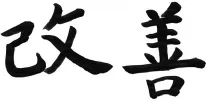![]()
1
WHAT IS KAIZEN?
![]()
Chapter 1
Kaizen and Continuous Improvement
It is not the strongest of the species that survives, nor the most intelligent, but the one most responsive to change.
—Charles Darwin
Paula Stanfill’s husband had open-heart surgery. Paula is the manager of the neonatal intensive care unit (NICU) at Franciscan St. Francis Health, a three-hospital system in Indianapolis, Indiana. In the recovery room, Paula’s husband could not speak because he was intubated with a breathing tube. He was trying to communicate by furrowing his eyebrows and squinting. He knew sign language and was motioning at his arm and trying to use his fingers to tell Paula something, but he could not make his hands do what he wanted them to do. Paula remembers her panic in realizing that something serious might be happening to her husband. He also began to panic, thinking the surgery had caused a serious problem with his arms. They were deeply distressed until the anesthesia wore off and he could speak again.
Paula learned her husband’s arms and hands were numb. He was a big man, and when the surgeons performed the procedure, they had leaned over his arms and put pressure on them, reducing the blood supply and causing the numbness. His arms remained numb for several weeks.
After this episode, Jessica Clendenen, a nurse in Franciscan’s cardiac operating room, learned that several other patients had experienced similar postoperative numbness. She decided to do something about it. In January of 2011, Jessica found some sled positioners that could be used to help tuck the patients’ arms in place in a way that allowed the IV lines to be seen through the clear material, as documented in Figure 1.1.
This small, simple improvement can be described as a “Kaizen.” It was an improvement that made a difference to open-heart patients at Franciscan and was one that Paula will never forget. When she started making these improvements, Paula never realized it would touch her so personally. But, after her husband’s experience, Paula realized that the heart of Kaizen is the difference it can make in people’s lives. Kaizen was no longer just a concept or a program to her; it had become a way of life.
Figure 1.1 A simple improvement that can be described as a Kaizen.
Kaizen = Change for the Better
The word Kaizen is translated from Japanese in a number of ways, most simply as “change for the better.”1 The Japanese characters are shown in Figure 1.2.
Breaking down the word:
A “Kaizen” is a small improvement that is made by those who do the work. It is a small, low-cost, low-risk improvement that can be easily implemented.2 Kaizen is an ongoing methodology and philosophy for challenging and empowering everyone in the organization to use their creative ideas to improve their daily work.
The word Kaizen, the way it is typically used, is synonymous with the phrase “continuous improvement.” An effective Kaizen approach is about making improvements that are connected to measurable results and a deeper purpose. Children’s Medical Center (Dallas, Texas), has a process improvement campaign that asks the simple question, “Is there a better way?” Clay York, manager of the core laboratory, and other leaders help tie the department’s local improvement efforts to the organization’s mission and purpose by asking team members if proposed changes will help provide “better care for kids.”3
Figure 1.2 “Kaizen” in Japanese kanji characters.
Beyond the measurable results, Kaizen organizations value the personal and organizational learning that results from the improvement process, as well as the personal pride and satisfaction of all who are involved.
IU Health Goshen Hospital has saved more than $30 million since 1998 with a program called “The Uncommon Leader” as part of its broader improvement program. In 2009, CEO James Dague promised to shave his head if employees generated ideas that saved $3.5 million that year. The hospital more than doubled that savings goal, so Dague shaved his head in front of his colleagues. The culture at Goshen has shifted to one where every person is empowered to make improvements to his or her daily work, making suggestions that can impact cost, quality, and patient care. For example, an emergency nurse educator saved $4,000 by changing the type of napkins used on patient trays and the GI department saved $22,000 by switching from disposable paper gowns to cloth gowns.4 Goshen has gone 17 years without layoffs, undoubtedly being a key reason its employees are so enthusiastic about improvement.5 Goshen was also named one of the top ten large employer workplaces in Indiana, in part due to its “workplace culture where employees feel valued.”6
Bubbles for Babies
Hope Woodard, an ultrasound tech at Franciscan St. Francis Health, noticed that her young patients were often uncomfortable when she pressed the cold hard ultrasound probe to their skin. They had difficulty staying still during the procedures. The parents would get frustrated and often could not find a way to calm their child down.
Hope thought about how she could create a better experience for her little customers. She brought in a small bottle of bubbles from a wedding she had attended and asked the parents to gently blow them over the top of the child to calm and entertain them, as documented in Figure 1.3. The bubbles were a real crowd pleaser, as they kept the babies calm for their procedures. Happy, distracted children allowed Hope and the other techs to capture better images for the radiologist that were obtained more quickly, making it better for the patient, for the parents, and for the ultrasound techs. In the course of making her job easier, Hope was also adding value to the customer experience. Her Kaizen was a win for her and a win for everyone involved. It created more joy in her work life every time she used bubbles for babies.
Figure 1.3 A simple Kaizen that improved staff and patient satisfaction.
These first examples of Kaizen have several things in common. They increase customer and patient satisfaction while, at the same time, improve the productivity and the quality of healthcare delivery. Small, low-cost improvements can indeed make a difference to patients while increasing the pride and joy felt by healthcare professionals.
Kaizen: A Powerful Word
The largest room in the world is the room for improvement.
—Author unknown
Kaizen. It is a strange-looking word. It might seem a little difficult to pronounce. Said out loud, it sounds a lot like “try–zen,” and we can equate it with the idea that we can try to improve and make things more zen-like in the workplace. Yes, Kaizen leads to a calmer, better-organized, more productive workplace that provides better patient care. Kaizen seems like a simple concept, really. But is this Japanese word intimidating to people in healthcare workplaces outside of Japan? Does the broader idea of improvement scare or intimidate people at all levels?
Hang in there, as this little word might be one of the most powerful words and concepts for improving healthcare processes and quality. Hospitals around the world are using this concept, often as part of a broader “Lean management” initiative. The period of “Lean healthcare” adoption that started around 2000 has proven that hospitals and healthcare organizations can improve when we have a highly engaged workforce focused on providing value to patients and minimizing waste in the delivery of care.















